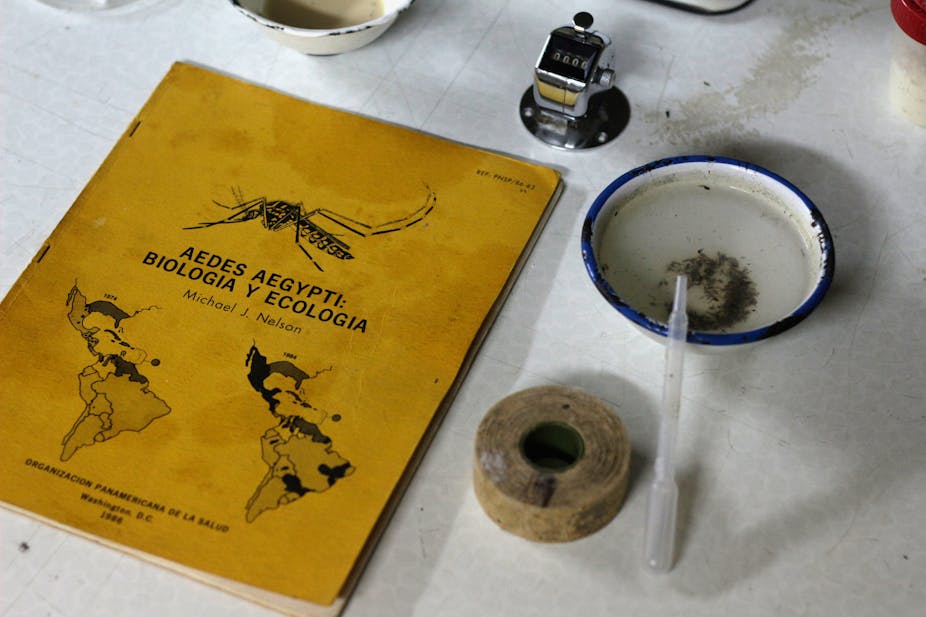While researchers work to develop a Zika virus vaccine to combat the outbreak spreading through South America, efforts to control the spread of the virus are focusing on the mosquito Aedes aegypti.

This particular mosquito is especially good at transmitting disease from one human to another. Besides Zika, this mosquito is also a vector for dengue, yellow fever and Chikungunya viruses.
I’ve been studying Ae. aegypti – where it lives and how it behaves – for 15 years. Aedes aegypti is adapted to live in close proximity with humans, and this close association likely contributes to the severity of this outbreak.
Aedes aegypti in a location near you?
Aedes aegypti is an invasive species to the Americas. It originated in Africa, and is thought to have been brought over with the early slave trade ships in the 15th through 17th century.
This mosquito is found in tropical and subtropical areas, which include all of Central and much of South America. In the U.S. it can be found readily in the Southeast and some small pockets in the Southwest, but not in areas that experience cold or freezing temperatures and more pronounced changes in daylight.
Aedes aegypti is a daytime biter, which means it’s active when its preferred food choice – human beings – are out and about.

Aedes aegypti just loves people
There are many species of mosquitoes, but not all of them spread diseases in people. Some prefer to feed on other mammals or birds. Ae. aegypti, however, prefers to feed on human beings. In fact, Aedes aegypti prefers human blood over that of other animals, which increases its ability to transmit viruses from person to person.
All mosquitoes are attracted to the carbon dioxide in our breath because it clues them into a live, breathing blood source.
Aedes aegypti females also detect odor cues from our sweat. They are attracted to the lactic acid and ammonia on our breath and skin, as well as the fatty acids secreted by the sebaceous glands at the base of our hair follicles (that would be the stuff that makes our hair look and smell oily).
Male Ae. aegypti feed on nectar and sugar, not blood, but they also can detect these odor cues so they can find potential mates that are hanging around humans.
While people generally smell good to female Ae. aegypti mosquitoes, some people smell especially good.
Your microbiota – the bacteria living on your skin – are another factor in this bouquet. Because we are all host to different groups of bacteria, we each have a different “smell” to the female mosquitoes, and that might be why some people smell more attractive than others.
And all of these factors vary with age. Because we get bigger with age, the skin surface area increases, so we can assume larger people (that is, adults) emit more of these attractants than smaller people (that is, children).

Aedes aegypti lay eggs in human-made containers
Besides finding human blood tasty, female Ae. aegypti tend to lay their eggs in human-made containers such as buckets, leftover cups, tires or cemetery vases that fill with water. Rain or daily watering from sprinkler systems makes containers including potted plant bases, birdbaths and fountains nice homes for the developing larvae.
Other mosquito species prefer natural sources of water to lay eggs, such as small ponds or near flooded creek beds. The species that prefer these habitats won’t have the same proximity to humans as the species that likes to lay eggs in our backyards, like Ae. aegypti.
Because the proximity of water sources to humans affects the chances of being bitten by a potentially infected mosquito, several researchers have begun to classify which water containers are more attractive to female Ae. aegypti. In one extensive study in Iquitos, Peru, where dengue is prevalent, researchers found several factors that make a site more attractive to females:
If larvae are already present in a container, the female knows that it has all the necessary requirements for her future offspring. It’s sort of like choosing a restaurant in an unknown city: if it’s crowded, then you know it’s good.
A neglected container is more attractive than a managed container, because it can accumulate more nutrients from decaying leaves or other organic matter. The more nutrients, the bigger the larvae will grow.
A container that receives more sunlight is more attractive because it’s warmer and mosquitoes need warm temperatures to develop.
Finally, size matters. Of those human-made containers that are near human activity, larger containers tend to have more developing larvae than smaller containers. However, even though size matters, we can still find larvae in containers as small as coke cans.
Educating the community about emptying unnecessary containers and covering larger water storage containers are an important part of the control effort and knowing what makes a container attractive can help people target specific containers. In areas where diseases transmitted by Ae. aegypti are present, this becomes extremely important.

Arming ourselves with more knowledge
Knowing that Ae. aegypti prefer humans, we can protect ourselves by wearing long-sleeved shirts and long pants, and using mosquito repellents that contain DEET or other CDC-approved repellents.
By clearing the areas around our homes of containers that can hold water or making sure we periodically empty our containers, we can reduce the population and thus reduce how often we are bitten.
Just because you’ve been bitten by a mosquito doesn’t mean you have been bitten by one that is carrying a disease. Even if you are bitten by an Ae. aegypti mosquito, it doesn’t necessarily mean that you have been exposed to Zika, or any other virus. Not all Ae. aegypti _are infected and not all mosquitoes are _Ae. aegypti.

